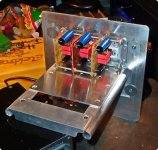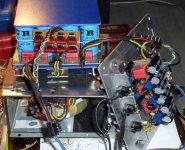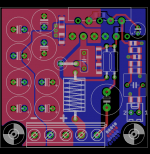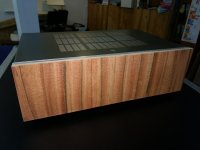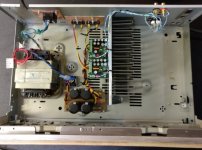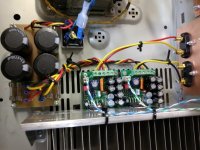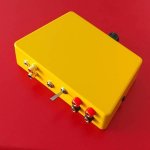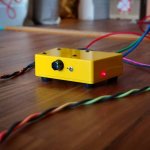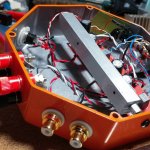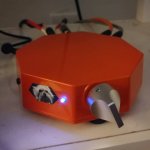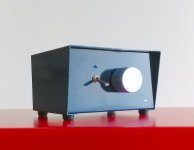Wow.
That is brutal. I hope that's dedicated for non-stop deathmetal.
That is brutal. I hope that's dedicated for non-stop deathmetal.
http://picture.in.th/id/6815b1743d7ef925c2e713ea3fe8c08e
Very, very nice glassound! Original mechanical engineering I must say. Thank you for sharing.
Best,
Anand.
Best,
Anand.
Thanks for all comment. I hope to see your amplifier too. We are diy we can do better commercial amplifier. ^__^
folsom-ec7293-battery-solarcell-powered-feedback
Loving the purple boards
my ship amp tda2050
Why not have fun with, eh? Great job. You’re never gonna see one of those in the shops are you!
Just finished a stereo lm3886. It's housed in a former receiver enclosure (reusing the old 24-0-24 transformer), with a veneered plywood new frontplate. PCB are my own. 4*4700uF/63V for the main PS.
As it will serve for a computer system where absolute fidelity isn't expected, I've only a 0db, -10db, -20db selector at the back; volume will be mostly digitally controlled. If I'm not too lazy, I might use all the available room for a DAC.
I still have to measure it in details but it seems fine. No offset, no noise, good sound.
As it will serve for a computer system where absolute fidelity isn't expected, I've only a 0db, -10db, -20db selector at the back; volume will be mostly digitally controlled. If I'm not too lazy, I might use all the available room for a DAC.
I still have to measure it in details but it seems fine. No offset, no noise, good sound.
Attachments
Your pcb layout is nice.
I dont like where your fuses are. If a fuse blows you lose a rail. Why not fuse the AC side? That way if a fuse blows you have zero problems besides whatever caused it to blow?
Uriah
I dont like where your fuses are. If a fuse blows you lose a rail. Why not fuse the AC side? That way if a fuse blows you have zero problems besides whatever caused it to blow?
Uriah
There is a fuse on the mains AC side (it's hidden in the iec block and is removed from the outside). But I suppose you rather meant between transformer secondaries and diode bridge ? I must admit I simply reused a PS from a class AB amp and those fuses are a protection against catastrophic failures, not really there to protect the load.
I would replace those fuses with wire and keep a fuse on the 120VAC side with a varistor like the CL60 in front of it to slow down the current inrush on turn on. Thats it. Just the one fuse. Put it on the 120VAC side so you can use a lower current fuse. Obviously do what you want, I dont want to be a know it all and just dispense advice for my own good, but I think your whole project and load would be safer with one single transformer primary side fuse.
Whole threads are already dedicated to that question... Maybe should we continue that discussion in another? In this particular case, the speakers I'll be using have caps on serie with both the woofer and tweeter. So they're pretty much DC safe.
A little class D module I put together for my grandma. Originally there was a different chip, mounted on the side of the case, but some erroneous troubleshooting led to me mounting the TPA3116 on the top. The same troubleshooting led to the 3.5mm input jack on the back going away, the original input switch on the front became the power switch, and I filled an original mounting hole with an LED. I like these little painted Hammond cases.
Attachments
Another one of these little Hammond chassis. After unsuccessfully trying to fit some tiny, $3.25 single-supply LM1875 modules in the yellow case, I figured out a creative heatsink solution using a piece of aluminum bar and got them situated in this orange octagon.
My spatial planning didn't work out perfectly and the power switch was sacrificed: sticker of my dog covering the extra hole. I think I'll hang an inline switch off the back if I want one rather than drill any more holes.
Using an 18V laptop supply and this little thing is doing great with my Tekton Lores.
My spatial planning didn't work out perfectly and the power switch was sacrificed: sticker of my dog covering the extra hole. I think I'll hang an inline switch off the back if I want one rather than drill any more holes.
Using an 18V laptop supply and this little thing is doing great with my Tekton Lores.
Attachments
Realized that my post with the Class D amp should be in the Class D section. It started out using a TDA7377 module and since that was my plan, I kept thinking of it as a chip amp even when my D'oh!-level mistakes led me to replace all the parts.
- Home
- Amplifiers
- Chip Amps
- Chip Amp Photo Gallery




